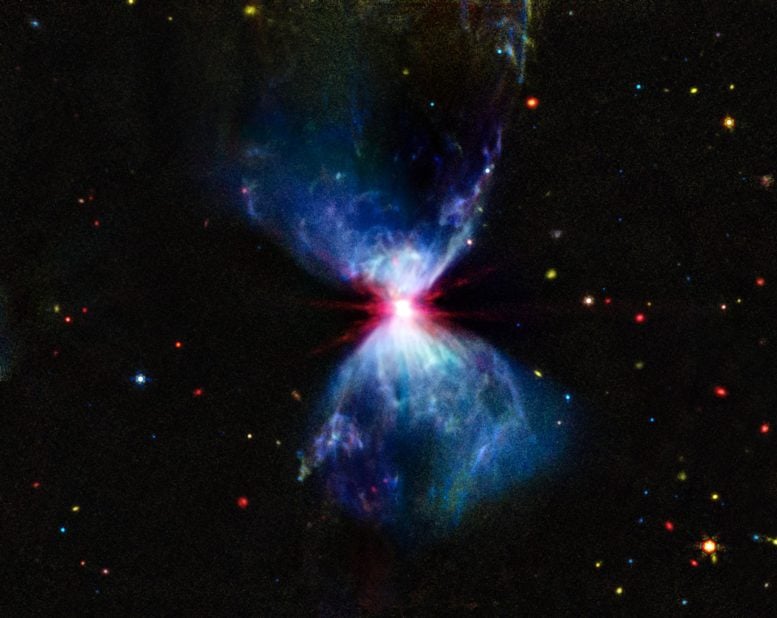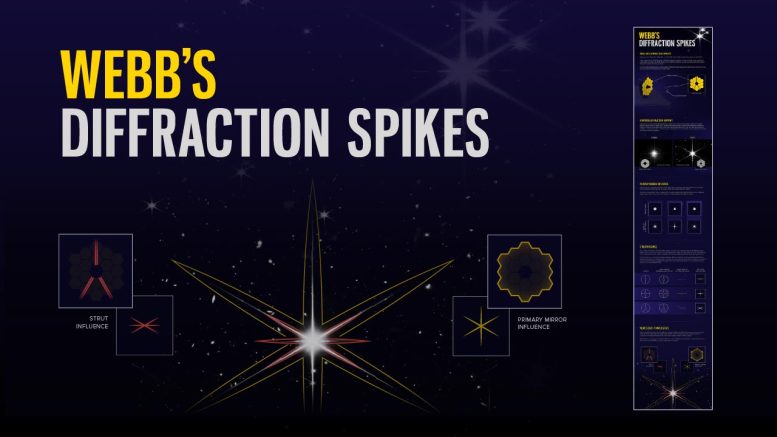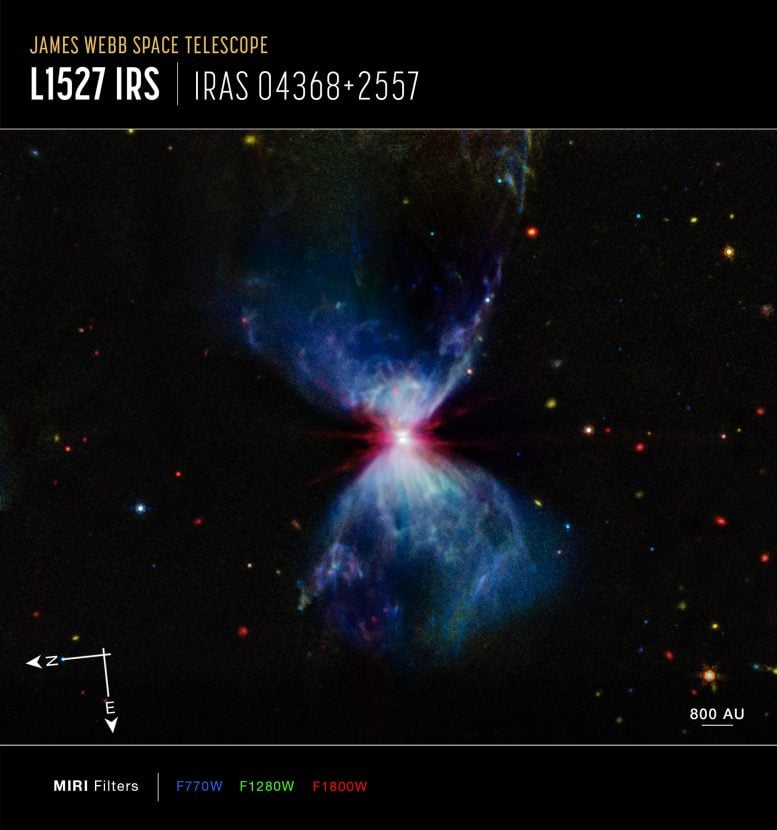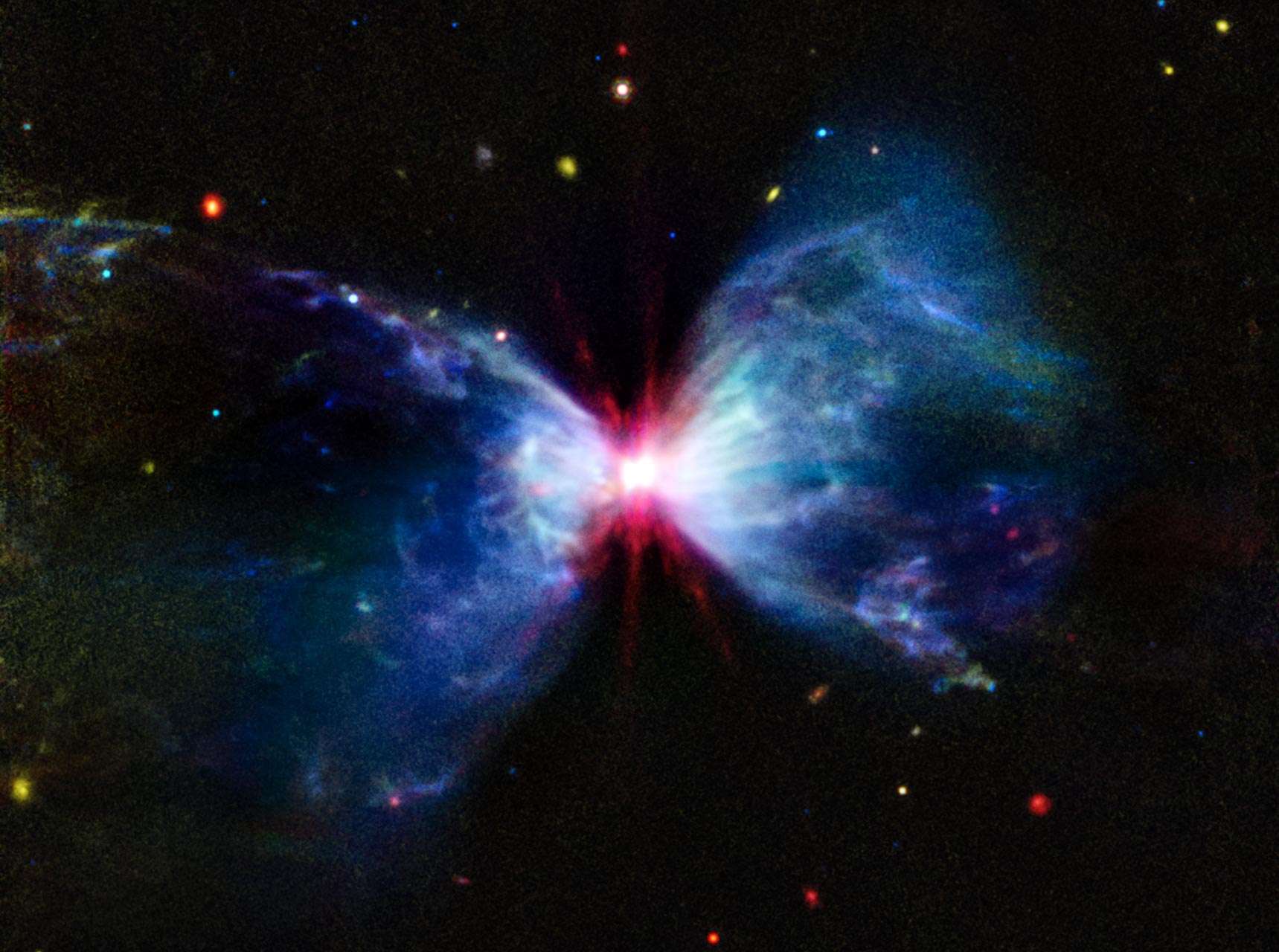This new image from NASA’s James Webb Space Telescope showcases a young protostar in the process of forming within a fiery hourglass-shaped molecular cloud. Captured using the MIRI instrument, this scene reveals dynamic outflows and bright regions caused by interactions with surrounding gases and dust. Credit: NASA, ESA, CSA, STScI
Webb’s latest mid-infrared image reveals a protostar’s formation, highlighted by color variations that detail its dynamic interactions with the surrounding molecular cloud.
NASA’s James Webb Space Telescope is celebrating U.S. Independence Day with an observation of the protostar, hidden inside the dark molecular cloud L1527 in mid-infrared light, as it evolves. This vibrant new view highlights the behavior of this young object and traces the different concentrations of gas and dust surrounding the protostar.

L1527, shown in this image from NASA’s James Webb Space Telescope’s MIRI (Mid-Infrared Instrument), is a molecular cloud that harbors a protostar. It resides about 460 light-years from Earth in the constellation Taurus. The more diffuse blue light and the filamentary structures in the image come from organic compounds known as polycyclic aromatic hydrocarbons (PAHs), while the red at the center of this image is an energized, thick layer of gases and dust that surrounds the protostar. The region in between, which shows up in white, is a mixture of PAHs, ionized gas, and other molecules. Credit: NASA, ESA, CSA, STScI
Webb Space Telescope Captures Celestial Fireworks Around Forming Star
The cosmos seems to come alive with a crackling explosion of pyrotechnics in this new image from NASA’s James Webb Space Telescope. Taken with Webb’s MIRI (Mid-Infrared Instrument), this fiery hourglass marks the scene of a very young object in the process of becoming a star. A central protostar grows in the neck of the hourglass, accumulating material from a thin protoplanetary disk, seen edge-on as a dark line.
Insights Into Protostellar Development
The protostar, a relatively young object of about 100,000 years, is still surrounded by its parent molecular cloud, or large region of gas and dust. Webb’s previous observation of L1527, with NIRCam (Near-Infrared Camera), allowed us to peer into this region and revealed this molecular cloud and protostar in opaque, vibrant colors.
Dynamic Outflows and Molecular Impact
Both NIRCam and MIRI show the effects of outflows, which are emitted in opposite directions along the protostar’s rotation axis as the object consumes gas and dust from the surrounding cloud. These outflows take the form of bow shocks to the surrounding molecular cloud, which appear as filamentary structures throughout. They are also responsible for carving the bright hourglass structure within the molecular cloud as they energize, or excite, the surrounding matter and cause the regions above and below it to glow. This creates an effect reminiscent of fireworks brightening a cloudy night sky. Unlike NIRCam, however, which mostly shows the light that is reflected off dust, MIRI provides a look into how these outflows affect the region’s thickest dust and gases.
The areas colored here in blue, which encompass most of the hourglass, show mostly carbonaceous molecules known as polycyclic aromatic hydrocarbons. The protostar itself and the dense blanket of dust and a mixture of gases that surround it are represented in red. The sparkler-like red extensions are an artifact of the telescope’s optics (see image below).

This illustration demonstrates the science behind Webb’s diffraction spike patterns, showing how diffraction spikes happen, the influence of the primary mirror and struts, and the contributions of each to Webb’s diffraction spikes. Credit: NASA, ESA, CSA, Leah Hustak (STScI), Joseph DePasquale (STScI)
In between, MIRI reveals a white region directly above and below the protostar, which doesn’t show as strongly in the NIRCam view. This region is a mixture of hydrocarbons, ionized neon, and thick dust, which shows that the protostar propels this matter quite far away from it as it messily consumes material from its disk.
Evolving Protostar and Its Future
As the protostar continues to age and release energetic jets, it’ll consume, destroy, and push away much of this molecular cloud, and many of the structures we see here will begin to fade. Eventually, once it finishes gathering mass, this impressive display will end, and the star itself will become more apparent, even to our visible-light telescopes.

This image of the nebula L1527, captured by Webb’s Mid-Infrared Instrument (MIRI), shows compass arrows, a scale bar, and a color key for reference.
The north and east compass arrows show the orientation of the image on the sky. Note that the relationship between north and east on the sky (as seen from below) is flipped relative to direction arrows on a map of the ground (as seen from above).
The scale bar is labeled in astronomical units (AU), which is the average distance between Earth and the Sun, or 93 million miles (150 million kilometers).
This image shows invisible mid-infrared wavelengths of light that have been translated into visible-light colors. The color key shows which MIRI filters were used when collecting the light. The color of each filter name is the visible light color used to represent the infrared light that passes through that filter.
Credit: NASA, ESA, CSA, STScI
The combination of analyses from both the near-infrared and mid-infrared views reveals the overall behavior of this system, including how the central protostar is affecting the surrounding region. Other stars in Taurus, the star-forming region where L1527 resides, are forming just like this, which could lead to other molecular clouds being disrupted and either preventing new stars from forming or catalyzing their development.
The James Webb Space Telescope (JWST), often hailed as the successor to the Hubble Space Telescope, is a large, space-based observatory optimized for infrared wavelengths. This enables it to look further back in time than any other telescope, observing the formation of the first galaxies and stars. Launched on December 25, 2021, JWST provides unprecedented resolution and sensitivity, allowing astronomers to study every phase of cosmic history across our universe. Its key capabilities include examining the atmospheres of exoplanets, observing distant galaxies, and exploring star formation in detail.

Dr. Thomas Hughes is a UK-based scientist and science communicator who makes complex topics accessible to readers. His articles explore breakthroughs in various scientific disciplines, from space exploration to cutting-edge research.








